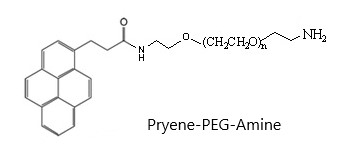Description
Pyrene-PEG-Amine is one of the many PEGylated pyrene derivatives for surface functionalization of carbon nanotubes and graphene. The strong (close to irreversible) pi-pi stacking between pyrene and the aromatic rings on single wall and multi-walled carbon nanotubes. Pyrene is conjugated to PEG through a very stable amide bond. It is a very simple process to prepare pyrene coated carbon nanoparticles (such as CNT). It requires just well dispersing CNTs with the PEG-pyrene reagents in either organic solvents or aqueous solutions. The same PEGylated pyrene reagent also works for graphene or any carbon nanoparticle surfaces with curvatures that fit well with the pyrene structure.
Properties
Molecular weight: MW of PEG was measured by MALDI-MS or GPC. PDI (polydispersity index) of our linear PEG is 1.02-1.05 with very narrow MW distribution. The number of repeating ethylene oxide units (CH2CH2O) or the degree of polymerization is calculated dividing the PEG MW by 44 (44 is the molecular mass of one repeating unit).
Solubility: Soluble in water and aqueous buffer, chloroform, methylene chloride, DMF, DMSO, and less soluble in alcohol, toluene. Not soluble in ether.
Density: PEG density is approximately 1.125 g/mL
Physical form: PEG products generally appear as white or off-white powder, and for very low MW linear PEG such as MW 1k or less, it may appear as wax-like, semi-solid material due to the low MW and the type of functional groups.
Storage condition: PEG product shall be stored in the original form as received in a freezer at -20C or lower for long term storage. Stock solution of PEG reagents that do not contain oxygen or moisture sensitive functional groups may be temporarily stored in a refrigerator or ambient temperature for multiple days. Stock solution should avoid repeated freeze-and-thaw cycles. See Documents section for detailed storage and handling conditions.
References
1. Alexey Tarasovet al, Highly sensitive, selective and label-free protein detection in physiological solutions using carbon nanotube transistors with nanobody receptors, Sensors and Actuators B: Chemical, 2017, DOI: 10.1016/j.snb.2017.08.164, Text
2. Charles M Lieber et al, Specific detection of biomolecules in physiological solutions using graphene transistor biosensors, Proc. Natl. Acad. Sci. USA, DOI 10.1073/pnas.1625010114, 2016,Text,PDF.
3. Effect of hydrophobic interaction in the poly(methacrylic acid)/pyrene end-labeled poly(ethylene glycol) complex,Macromolecules,1987, 20 (8), pp 1839, Text.
4. Non-covalent and reversible functionalization of carbon nanotubes, Beilstein J. Nanotechnol.2014, 5, 1675, Text.
Click here to view an expanded list of hundreds of publications citing Creative PEGWorks products.


